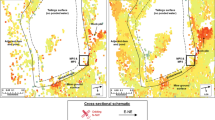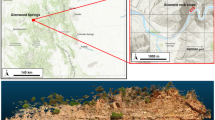Abstract
Early detection of rockslides at high-elevation and well-vegetated slopes remains challenging. This study used satellite and unmanned aerial vehicle (UAV) optical remote-sensing (ORS) images to track evidence of slope deformation and examine potential geomorphological precursors of five large rockslides in China. The multi-temporal image interpretation results were combined with available pre-sliding slope displacement data derived from synthetic aperture radar (SAR) or field monitoring to study the temporal changes in geomorphological precursors accompanying slope deformation. All the surveyed landslides had cracks or scarps and rockfalls within the landslide source area before the onset of rapid sliding. These precursors can be identified in ORS images taken several years or decades before the rapid slope failure, which provides sufficient time for the landslide early detection in practice. Local topography affects the spatial locations of cracks or scarps. Rockfalls within the landslide source area tend to locate at “key blocks” where slope mass provides forces resisting sliding. The rockfall area ratio, defined as the accumulated area of rockfalls over the landslide source area, ranged from 0.33 to 0.92 before rapid slope failure. The landslides developed on anti-dip and igneous rock slopes show a more significant rise of rockfall area ratio before the slope failure than the landslides on dip slopes. Given the broad availability of ORS data, this study could shed light on the ORS-based landslide early detection and landslide kinematics study.













Similar content being viewed by others
References
Bürgmann R, Rosen PA, Fielding EJ (2000) Synthetic aperture radar interferometry to measure Earth’s surface topography and its deformation. Annu Rev Earth Planet Sci 28(1):169–209
Carlà T, Intrieri E, Raspini F, Bardi F, Farina P, Ferretti A, Colombo D, Novali F, Casagli N (2019) Perspectives on the prediction of catastrophic slope failures from satellite InSAR. Sci Rep 9(1):1–9
Carter W, Shrestha R, Tuell G, Bloomquist D, Sartori M (2001) Airborne laser swath mapping shines new light on Earth’s topography. Eos 82(46):549–555
Casagli N, Cigna F, Bianchini S, Hölbling D, Füreder P, Righini G, Del Conte S, Friedl B, Schneiderbauer S, Iasio C, Vlcko J (2016) Landslide mapping and monitoring by using radar and optical remote sensing: examples from the EC-FP7 project SAFER. Remote Sens Appl: Soc Environ 4:92–108
Chen L, Zhao C, Kang Y, Chen H, Yang C, Li B, Liu Y, Xing A (2020) Pre-event deformation and failure mechanism analysis of the Pusa landslide, China with multi-sensor SAR imagery. Remote Sens 12(5):856
Chigira M, Kiho K (1994) Deep-seated rockslide-avalanches preceded by mass rock creep of sedimentary rocks in the Akaishi Mountains, central Japan. Eng Geol 38(3–4):221–230
Chigira M, Wang W, Furuya T, Kamai T (2003) Geological causes and geomorphological precursors of the Tsaoling landslide triggered by the 1999 Chi-Chi earthquake. Taiwan Eng Geol 68(3–4):259–273
Chigira M, Duan F, Yagi H, Furuya T (2004) Using an airborne laser scanner for the identification of shallow landslides and susceptibility assessment in an area of ignimbrite overlain by permeable pyroclastics. Landslides 1(3):203–209
Chigira M (2009) September 2005 rain-induced catastrophic rockslides on slopes affected by deep-seated gravitational deformations, Kyushu, southern Japan. Eng Geol 108(1–2):1–15
Chigira M, Wu X, Inokuchi T, Wang G (2010) Landslides induced by the 2008 Wenchuan earthquake, Sichuan. China Geomorphology 118(3–4):225–238
Chigira M, Tsou CY, Matsushi Y, Hiraishi N, Matsuzawa M (2013) Topographic precursors and geological structures of deep-seated catastrophic landslides caused by Typhoon Talas. Geomorphology 201:479–493
Cohen-Waeber J, Bürgmann R, Chaussard E, Giannico C, Ferretti A (2018) Spatiotemporal patterns of precipitation-modulated landslide deformation from independent component analysis of InSAR time series. Geophys Res Lett 45(4):1878–1887
Delacourt C, Allemand P, Berthier E, Raucoules D, Casson B, Grandjean P, Pambrun C, Varel E (2007) Remote-sensing techniques for analysing landslide kinematics: a review. Bull Soc Geol Fr 178(2):89–100
Fan X, Xu Q, Scaringi G, Dai L, Li W, Dong X, Zhu X, Pei X, Dai K, Havenith HB (2017) Failure mechanism and kinematics of the deadly June 24, 2017 Xinmo landslide, Maoxian, Sichuan. China Landslides 14(6):2129–2146
Fan X, Xu Q, Scaringi G, Zheng G, Huang R, Dai L, Ju Y (2019) The “long” runout rock avalanche in Pusa, China, on August 28, 2017: a preliminary report. Landslides 16(1):139–154
Gong W, Juang CH, Wasowski J (2021) Geohazards and human settlements: Lessons learned from multiple relocation events in Badong. China-Engineering Geologist’s Perspective Eng Geol 285:106051
Haugerud RA, Harding DJ, Johnson SY, Harless JL, Weaver CS, Sherrod BL (2003) High-resolution lidar topography of the Puget Lowland. Washington GSA Today 13(6):4–10
Hervás J, Barredo JI, Rosin PL, Pasuto A, Mantovani F, Silvano S (2003) Monitoring landslides from optical remotely sensed imagery: the case history of Tessina landslide. Italy Geomorphology 54(1–2):63–75
Huang R (2007) Large-scale landslides and their sliding mechanisms in China since the 20th century. Chin J Rock Mech Eng 26(31):433–454 (in Chinese with English abstract)
Huggel C (2009) Recent extreme slope failures in glacial environments: effects of thermal perturbation. Quat Sci Rev 28(11–12):1119–1130
Intrieri E, Raspini F, Fumagalli A, Lu P, Del Conte S, Farina P, Allievi J, Ferretti A, Casagli N (2018) The Maoxian landslide as seen from space: detecting precursors of failure with Sentinel-1 data. Landslides 15(1):123–133
Intrieri E, Carlà T, Gigli G (2019) Forecasting the time of failure of landslides at slope-scale: a literature review. Earth Sci Rev 193:333–349
Jaboyedoff M, Pedrazzini A, Horton P, Loye A, Surace I (2008) Preliminary slope mass movements susceptibility mapping using LIDAR DEM. In: Proceedings of 61st Canadian geotechnical conference, pp 419–426
Jaboyedoff M, Oppikofer T, Locat A, Locat J, Turmel D, Robitaille D, Demers D, Locat P (2009) Use of ground-based LIDAR for the analysis of retrogressive landslides in sensitive clay and of rotational landslides in river banks. Can Geotech J 46:1379–1390
Jaboyedoff M, Oppikofer T, Abellán A, Derron MH, Loye A, Metzger R, Pedrazzini A (2012) Use of LIDAR in landslide investigations: a review. Nat Hazards 61(1):5–28
Kromer RA, Hutchinson DJ, Lato MJ, Gauthier D, Edwards T (2015) Identifying rock slope failure precursors using LiDAR for transportation corridor hazard management. Eng Geol 195:93–103
Lee S (2005) Application of logistic regression model and its validation for landslide susceptibility mapping using GIS and remote sensing data. Int J of Remote Sens 26(7):1477–1491
Li M, Zhang L, Ding C, Li W, Luo H, Liao M, Xu Q (2020) Retrieval of historical surface displacements of the Baige landslide from time-series SAR observations for retrospective analysis of the collapse event. Remote Sens Environ 240:111695
Lin F, Wu LZ, Huang RQ, Zhang H (2018) Formation and characteristics of the Xiaoba landslide in Fuquan, Guizhou. China Landslides 15(4):669–681
Nishii R, Matsuoka N, Daimaru H, Yasuda M (2013) Precursors and triggers of an alpine rockslide in Japan: the 2004 partial collapse during a snow-melting period. Landslides 10(1):75–82
Ouyang C, Zhao W, Xu Q, Peng D, Li W, Wang D, Zhou S, Hou S (2018) Failure mechanisms and characteristics of the 2016 catastrophic rockslide at Su village, Lishui. China Landslides 15(7):1391–1400
Ouyang C, Zhao W, An H, Zhou S, Wang D, Xu Q, Li W, Peng D (2019) Early identification and dynamic processes of ridge-top rockslides: implications from the Su Village landslide in Suichang County, Zhejiang Province. China Landslides 16(4):799–813
Pánek T, Klimeš J (2016) Temporal behavior of deep-seated gravitational slope deformations: A review. Earth Sci Rev 156:14–38
Paronuzzi P, Bolla A (2015) Gravity-induced rock mass damage related to large en masse rockslides: evidence from Vajont. Geomorphology 234:28–53
Piroton V, Schlögel R, Barbier C, Havenith HB (2020) Monitoring the recent activity of landslides in the Mailuu-Suu Valley (Kyrgyzstan) using radar and optical remote sensing techniques. Geosci 10(5):164
Qi W, Yang W, He X, Xu C (2021) Detecting Chamoli landslide precursors in the southern Himalayas using remote sensing data. Landslides 18(10):3449–3456
Qin CA, Chen G, Zhu J, Tang P (2020) A precursor of bedding rockslide: rock spalling in the key block triggered by tensile cracks. Bull Eng Geol Environ 79(5):2513–2528
Teza G, Galgaro A, Zaltron N, Genevois R (2007) Terrestrial laser scanner to detect landslide displacement fields: a new approach. Int J Remote Sens 28(16):3425–3446
Wang WN, Chigira M, Furuya T (2003) Geological and geomorphological precursors of the Chiu-fen-erh-shan landslide triggered by the Chi-chi earthquake in central Taiwan. Eng Geol 69(1–2):1–13
Wasowski J, Bovenga F (2014) Investigating landslides and unstable slopes with satellite Multi-Temporal Interferometry: Current issues and future perspectives. Eng Geol 174:103–138
Xing A, Xu Q, Zhu Y, Zhu J, Jiang Y (2016) The August 27, 2014, rock avalanche and related impulse water waves in Fuquan, Guizhou. China Landslides 13(2):411–422
Xu Q, Zheng G, Li W, He C, Dong X, Guo C, Feng W (2018) Study on Successive Landslide Damming Events of Jinsha River in Baige Village of October 11 and November 3, 2018. J Eng Geol 26(6):1534–1551 (in Chinese with English abstract)
Zhang M, McSaveney M, Shao H, Zhang C (2018) The 2009 Jiweishan rock avalanche, Wulong, China: precursor conditions and factors leading to failure. Eng Geol 233:225–230
Acknowledgements
The authors would like to thank the editor and three anonymous reviewers for providing constructive comments that improved the quality of this article. The corresponding author would like to thank Professor C. Hsein Juang for giving valuable advice on writing.
Funding
This research is supported by the National Key Research and Development Program of China (Grant No. 2021YFC3000401), the National Key Research and the National Natural Science Foundation of China (Grant Nos. 41941019), and the Second Tibetan Plateau Scientific Expedition and Research Program (STEP) (Grant No. 2019QZKK0201).
Author information
Authors and Affiliations
Corresponding author
Ethics declarations
Conflict of interest
The authors declare no competing interests.
Rights and permissions
Springer Nature or its licensor holds exclusive rights to this article under a publishing agreement with the author(s) or other rightsholder(s); author self-archiving of the accepted manuscript version of this article is solely governed by the terms of such publishing agreement and applicable law.
About this article
Cite this article
Li, W., Zhan, W., Lu, H. et al. Precursors to large rockslides visible on optical remote-sensing images and their implications for landslide early detection. Landslides 20, 1–12 (2023). https://doi.org/10.1007/s10346-022-01960-1
Received:
Accepted:
Published:
Issue Date:
DOI: https://doi.org/10.1007/s10346-022-01960-1




